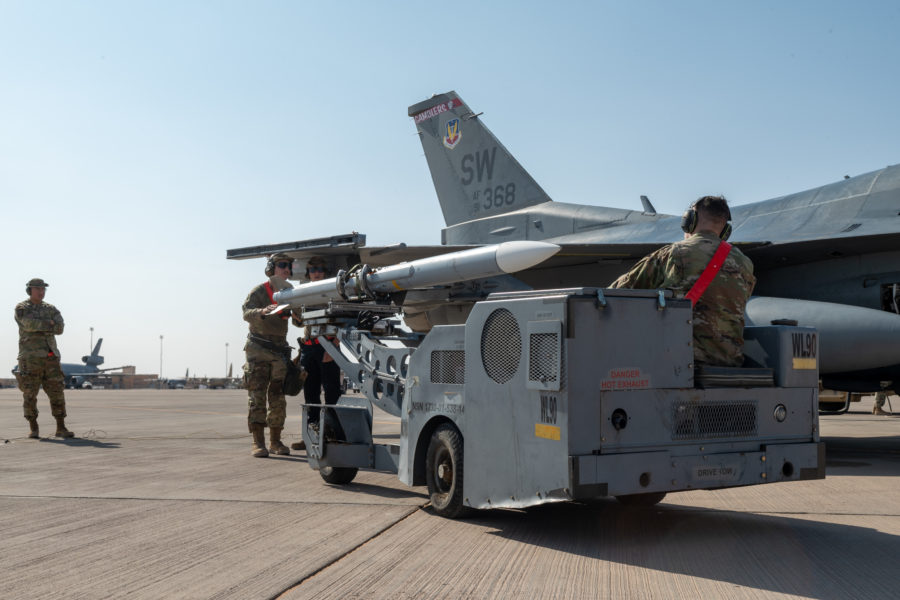The latest version of the AIM-120 AMRAAM, the Air Force’s primary air-to-air weapon, has been cleared for fleet deployment later this year, according to Raytheon, the missile’s builder.
The Air Force is planning a multiyear procurement of the missile to bridge the gap until its successor, the highly classified AIM-260 Joint Advanced Tactical Missile, is in production at scale, according to service leaders and fiscal 2024 budget request documents.
The AIM-120D-3 has completed the Air Force’s “Functional Configuration Audit” and is “on track toward fielding by both the Air Force and Navy this year,” Raytheon said in a press release. The upgrade program that keeps the AMRAAM capable of dealing with advanced threats is known as the Form, Fit, Function Refresh, or F3R.
The D-3 version of the missile includes 15 upgraded circuit cards and uses the latest software available, the company said.
“The missile brings tremendous capability to counter both current and future threats and is postured to receive continuous agile software enhancements,” the company said. The Functional Configuration Audit included bench testing, captive carry flights, and live fires from multiple USAF and Navy platforms, Raytheon noted. An FCA of an exportable version, the AIM-120 C-8 variant, will be completed later this year.
Air Force 2024 budget documents state the AIM-120D variant “delivers improved performance via Global Positioning System (GPS)-aided navigation; two way datalink capability for enhanced aircrew survivability and improved network compatibility; and incorporates new guidance software that improves kinematic performance and weapon effectiveness.”
The AIM-120 is used on “14 platforms in 42 countries,” Raytheon noted in its release. All future AMRAAM production will consist of D3 or C8 variants.
Production of the missile had been winding down—with 317 units purchased in fiscal 2022 and 271 in 2023—as the Air Force planned to ramp up production of the longer-ranged AIM-260 JATM around 2022 and achieve initial operational capability with the missile that year.
However, in the 2024 budget, the planned AMRAAM buy jumps back up to 457 units, followed by 462 in fiscal 2025 and 664 in 2026, before a sharp downturn to 118 in 2027 and just nine in 2028 and a further 27 missiles expected for the rest of the program.
Speaking at a Mitchell Institute for Aerospace Studies event April 6, Lt. Gen. Richard G. Moore Jr., vice chief of staff for plans and programs, said the AMRAAM program’s revised trajectory is driven in part by concerns of lawmakers that the industrial base’s ability to surge production of many weapon systems during wartime is very limited. The issue has been highlighted as reports indicate it will take the U.S. years to replenish its stocks with weapons being provided to Ukraine in its fight against Russia.
Now, “any munitions line that’s hot and is producing weapons right now” is getting a boost, Moore said.
It’s not limited to AMRAAM, either, he added.
“It’s any place where we can buy munitions,” Moore said. “Because the reality is, when we tried to surge [for] … Ukraine, the surge capacity wasn’t there. And industry is ramping up as quickly as they possibly can.”
Air Force budget justification documents for AMRAAM say there is an “industrial leadtime of 40 months” between ordering the missiles and taking delivery.
Asked if the reversal of direction on AMRAAM production indicates a problem with JATM, Moore said the service is not seeing a delay at the moment.
The JATM was revealed at a 2019 industry conference by the program executive officer for armaments at that time, Brig. Gen. (now Maj. Gen.) Anthony Genatempo, now the PEO for command, control, communications and networks. The JATM has significantly longer range than AMRAAM and addresses the longer range of threat missiles, like China’s advanced PL-15, which has a longer reach than AMRAAM.
Moore said JATM is still progressing, and some of the facilitization funding requested for AMRAAM in the 2024 budget “will help us to get to JATM faster.”
Once JATM, made by Lockheed Martin, goes into production, he said, “we’ll get to quantity as fast as we can.”
The AMRAAM’s funding decline in the latter part of the decade may suggest the timing of the Air Force’s ramp-up in JATM production, likely with some overlap.
Budget documents say the Air Force is “initiating a Multiyear Procurement (MYP) strategy for AMRAAM; JASSM; LRASM; and Standard Missile-6, under the Large Lot Procurement (LLP) concept.” The JASSM and LRASM are variants of the AGM-158 stealthy cruise missile; the former intended for land targets and the latter for ships. Th SM-6 is a Navy ship-based anti-aircraft missile.
The multiyear procurement strategy across all these systems at once is intended to produce “synergies in production across different but related programs” which can generate efficiencies, the budget documents said, which in turn can “result in greater production capacity, accelerated delivery, and lower unit costs.”
The documents said the LLP concept builds on the existing multiyear construct, leveraging the savings derived from economic order quantities “to procure additional lots of missiles under a buy-to-budget concept, to further improve efficiencies and yields.”
The Air Force buys AMRAAM for itself and the Navy.
